Death and Literature
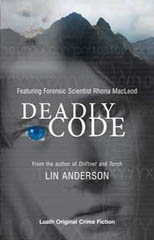 Lin Anderson: I did a diploma in forensic medical sciences at Glasgow University. It’s really for lawyers, pathologists, forensics people, policemen, mortuary assistants – anyone who might have to give forensic evidence in court, so that top criminal lawyers don’t shoot them down in flames – you know who I mean, the one with the handlebar moustache, he’s very good at his job. The advertisement in the Herald said ‘Any interested persons’, and I thought ‘That’s me!’ It turned out another crime writer that I know ended up in the same course with me. It was completely fascinating. Nothing I write in any book could ever be as weird and wonderful as what happens in Glasgow over a weekend. You had to have quite a strong stomach. We saw the full photographs. What was very interesting was, for us it was almost fiction – we would think ‘What a good idea’, and take a note. We were standing back, looking at it from a story aspect. They were very careful in the cases they talked to you about, it tended to be the villains killing the villains. I don’t know if you’re aware that their population has more murders than New York. That sounds absolutely terrible, it is terrible, but it’s still that most of it happens between the bad guys fighting over their drug areas. Doing the course also meant you had wonderful people to speak to…
Lin Anderson: I did a diploma in forensic medical sciences at Glasgow University. It’s really for lawyers, pathologists, forensics people, policemen, mortuary assistants – anyone who might have to give forensic evidence in court, so that top criminal lawyers don’t shoot them down in flames – you know who I mean, the one with the handlebar moustache, he’s very good at his job. The advertisement in the Herald said ‘Any interested persons’, and I thought ‘That’s me!’ It turned out another crime writer that I know ended up in the same course with me. It was completely fascinating. Nothing I write in any book could ever be as weird and wonderful as what happens in Glasgow over a weekend. You had to have quite a strong stomach. We saw the full photographs. What was very interesting was, for us it was almost fiction – we would think ‘What a good idea’, and take a note. We were standing back, looking at it from a story aspect. They were very careful in the cases they talked to you about, it tended to be the villains killing the villains. I don’t know if you’re aware that their population has more murders than New York. That sounds absolutely terrible, it is terrible, but it’s still that most of it happens between the bad guys fighting over their drug areas. Doing the course also meant you had wonderful people to speak to…
As a student I went to Glasgow University, but I also went to Edinburgh University, so I’ve crossed the divide. I wanted Rhona MacLeod [protagonist in all of Anderson's crime stories] to be looking down on Kelvingrove, the park and the gallery, because I loved that. As a student I used to go and sit out the front and have my sandwiches at lunchtime and look at this fabulous view. I placed Rhona’s laboratory so she had a cracking view. I said to one of the major pathologists in Glasgow, John Parks, after he read the books, that I think the actual forensics department is down towards Byers Road, right at the bottom of the hill – no view, horrible, bricky crappy building, and he said ‘Actually, I think Rhona is in the principal’s office.’
Forensics is fascinating, but… you can’t give too much detail. You have to give enough to keep people interested, but it’s about people. If you overload the book with the science aspect it’s not fun. They’ve got a great department at Glasgow called GUARD – Glasgow University Archaeology Department – and they do a lot of stuff for anthropological forensics and that. They also analyse stomach contents. One of my friends there told me she’d just been up in court, and the deceased had eaten a Burger King a few hours before they died. I said ‘It might have been a McDonald’s’, and she said ‘No, it was definitely a Burger King.’ ‘How do you know?’ I asked. She said, ‘Because they cut their gherkins differently!’ I have a huge degree of respect for the professional way these people go about their business, their respect for the victims, and their determination to find out how this happened, try and get the people who did it.
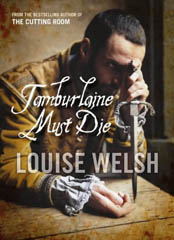 Louise Welsh: Everybody has their own philosophies and their own ethics and their own ideas. Last week I met Bret Easton Ellis. American Psycho… very worrying… I’ve read it probably more times than anybody should read that book! I asked him ‘Do you consider yourself a writer with morals and ethics?’ and he said ‘Well, of course I’d like to say yes.’ And I thought ‘Yeah, we all think we have these ethics, we like to justify what we do.’ I get criticised more for the sex in my books – although there’s never been any non-consensual sex so far. The violence is very rarely criticised. There’s a very high tolerance for violence. In American Psycho the violence is horrible, not slick, not smooth, not smart. When we’re reading these scenes we should feel ‘Uggh, yuck’, because that’s what it’s like in real life.
Louise Welsh: Everybody has their own philosophies and their own ethics and their own ideas. Last week I met Bret Easton Ellis. American Psycho… very worrying… I’ve read it probably more times than anybody should read that book! I asked him ‘Do you consider yourself a writer with morals and ethics?’ and he said ‘Well, of course I’d like to say yes.’ And I thought ‘Yeah, we all think we have these ethics, we like to justify what we do.’ I get criticised more for the sex in my books – although there’s never been any non-consensual sex so far. The violence is very rarely criticised. There’s a very high tolerance for violence. In American Psycho the violence is horrible, not slick, not smooth, not smart. When we’re reading these scenes we should feel ‘Uggh, yuck’, because that’s what it’s like in real life.
I guess I consider myself a feminist. I’m very concerned with the way women’s bodies are sometimes used, especially in films. You’ll see a movie and the woman’s body will be there to just hold your interest as a prop, like this table – there’s been a murder, and there’s a naked female body on the floor. This idea of the dead supine female somehow being more arresting in a way – you see it a lot in advertising, this very passive naked female who might as well be dead, so when I came to write The Cutting Room I was worried about writing about what I don’t like, in a sense. How do you write about sexual exploitation or its visual use without recreating it? In the end you come down to your own tightrope, and some people will think you’ve got it right, some people might think you haven’t. That was part of the idea of using photographs as well, trying to make one removed from this body on the floor, and also try to point up the way in which photography is very much a powerful medium that we can use in that way.
So yeah, I think I do have ethics, that there’s things that I dislike in books. I dislike when a murder is somehow just a prop, and yet people could probably criticise my writing on their own grounds. I would never tell somebody what they can do or what they can’t. It’s always going to be a personal thing – but I do prefer a good book with a lot of blood and something that makes me feel a little bit, rather than something that’s very genteel – maybe something that’s representing a vision of Scotland that I don’t recognise. It doesn’t have to be completely realist, but I like to be able to recognise it on an emotional level somehow.
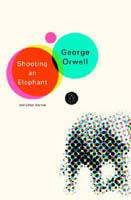 I love that George Orwell essay when he’s writing about the decline of the English murder, and he starts off painting this very beautiful picture of somebody in a suburban home, they’ve had a hard week, they’ve had their Sunday breakfast, maybe the kids are all out, he sits down to read the Sunday papers, and he says ‘And what we like to read about, of course, we like to read about a murder.’ And Orwell goes on to say, and in many ways I don’t agree with him because I find reading about real murders – it’s not a pleasant thing to read about, to have it filtered through fiction, but there’s a lot we can learn through the lens of fiction, start looking at the violence of our society through fiction, it makes us question a lot of what else is going on in society.
I love that George Orwell essay when he’s writing about the decline of the English murder, and he starts off painting this very beautiful picture of somebody in a suburban home, they’ve had a hard week, they’ve had their Sunday breakfast, maybe the kids are all out, he sits down to read the Sunday papers, and he says ‘And what we like to read about, of course, we like to read about a murder.’ And Orwell goes on to say, and in many ways I don’t agree with him because I find reading about real murders – it’s not a pleasant thing to read about, to have it filtered through fiction, but there’s a lot we can learn through the lens of fiction, start looking at the violence of our society through fiction, it makes us question a lot of what else is going on in society.
LA: Why do so many women write crime, why do so many read it? There are a variety of reasons for writing something like crime. It is a sort of a puzzle, and I love the puzzle aspect of it, the fitting together of the jigsaw. But also, when you write crime, you fix it. You get the bad guy. Nobody will read your books if the bad guy is not caught at the end. It might not work out pat and beautiful, but the fact is you do sort it. You can’t sort it in real life, but you can sort it in a book. It’s a way of looking at the world, especially dark aspects of the world, but they’re fixed at the end. There’s a feeling that maybe sometimes we do win.
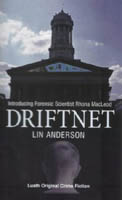 In my first novel, Driftnet, about the paedophilia – do you remember the terrible massacre of the children up at Dunblane? I was teaching that day, and I had to stay late to do an event about child abuse. During that day we suddenly get someone running into the classroom shouting ‘Oh my god this terrible thing has happened at a school in Dunblane.’ If you’re teaching in a school and you hear that sort of news… it was horrendous. It was the most terrible thing. You had to stay in the school with the kids, but all of the parents just wanted their kids home. I wanted to go home to my own kids. But they had set up this thing for us, so we had to stay for two hours and listen to these lectures about child abuse. And one of the ladies who came to speak to us, a social worker from Glasgow, said to us that they had just discovered there were three separate paedophile rings working in Glasgow. The internet was just coming in at that time, and they thought they were going to use the internet. And now that’s all proved to be true, but I went home, and it stuck in my head. In a way, writing Driftnet was my way of facing that scenario, but also working my way through it. Some parents have said they’ve given the book to their older children and said ‘Read this book’ because you learn about the world through drama and books. It’s much more powerful than if your parent just says ‘Don’t go onto those sites, don’t walk down wee dark places at night.’
In my first novel, Driftnet, about the paedophilia – do you remember the terrible massacre of the children up at Dunblane? I was teaching that day, and I had to stay late to do an event about child abuse. During that day we suddenly get someone running into the classroom shouting ‘Oh my god this terrible thing has happened at a school in Dunblane.’ If you’re teaching in a school and you hear that sort of news… it was horrendous. It was the most terrible thing. You had to stay in the school with the kids, but all of the parents just wanted their kids home. I wanted to go home to my own kids. But they had set up this thing for us, so we had to stay for two hours and listen to these lectures about child abuse. And one of the ladies who came to speak to us, a social worker from Glasgow, said to us that they had just discovered there were three separate paedophile rings working in Glasgow. The internet was just coming in at that time, and they thought they were going to use the internet. And now that’s all proved to be true, but I went home, and it stuck in my head. In a way, writing Driftnet was my way of facing that scenario, but also working my way through it. Some parents have said they’ve given the book to their older children and said ‘Read this book’ because you learn about the world through drama and books. It’s much more powerful than if your parent just says ‘Don’t go onto those sites, don’t walk down wee dark places at night.’
These stories are important. They show people in difficult and extreme circumstances. We don’t all experience anything like that, but it lets us see that part of life, and think about how you’d deal with it.
LW: It’s amazing what a place the web has become in fiction. As well as crime fiction I’m interested in Gothic conventions and it’s struck me that the web is a new Gothic place. Although it’s virtual, it doesn’t really exist, it’s a dark labyrinth where we can travel almost everywhere. I think very much that fiction is someplace we can face our fears. We can go places in novels which would perhaps be dangerous and undesirable for us to physically tread.
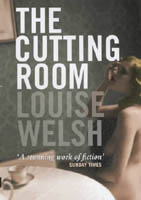 The Cutting Room, my first book, was taken by Tam Dean Burn, a very good Edinburgh actor, who adapted it for the stage at the Citizen’s Theatre in Glasgow. It was a brilliant experience for me. When you write, you write on your own, and you write with your own vision. I knew Tam, I knew his work, I really trusted him and his politics. I was very comfortable giving the book to him. I knew he would do a good job. When you hand your work to someone else, you have to have that trust, you can’t be looking over somebody’s shoulders and going ‘Er, I wouldn’t do it that way.’ It was very interesting what he took out of it, because of course a play is much smaller than a book. He had to discard most of it, and he took exactly what in retrospect you’d expect – the love, money, violence plots. It was amazing to see it on stage; it was a two person production, Tam and Anne Marie Timoney. They didn’t just play their own gender, they would swap, so Anne would play men and Tam would play women. I don’t think it’s just an excuse to get into high heels! He did it brilliantly. I would do it again, with Tam or someone I trusted as much as him, not someone I hadn’t been able to have a good exchange with. It has to be the right person.
The Cutting Room, my first book, was taken by Tam Dean Burn, a very good Edinburgh actor, who adapted it for the stage at the Citizen’s Theatre in Glasgow. It was a brilliant experience for me. When you write, you write on your own, and you write with your own vision. I knew Tam, I knew his work, I really trusted him and his politics. I was very comfortable giving the book to him. I knew he would do a good job. When you hand your work to someone else, you have to have that trust, you can’t be looking over somebody’s shoulders and going ‘Er, I wouldn’t do it that way.’ It was very interesting what he took out of it, because of course a play is much smaller than a book. He had to discard most of it, and he took exactly what in retrospect you’d expect – the love, money, violence plots. It was amazing to see it on stage; it was a two person production, Tam and Anne Marie Timoney. They didn’t just play their own gender, they would swap, so Anne would play men and Tam would play women. I don’t think it’s just an excuse to get into high heels! He did it brilliantly. I would do it again, with Tam or someone I trusted as much as him, not someone I hadn’t been able to have a good exchange with. It has to be the right person.
I think I’d give the same advice to a crime writer as I would to any writer: sit down and do it. You can spend a long time thinking about wanting to do it, put it off, think ‘Well I can’t do it this week because I’m awful busy.’ And that’s true – we are awful busy. What works for me, or what worked for me when I was working another job as well, is to say ‘I’ll sit down at this time, and I won’t get up from my desk till this time’, and sometimes you don’t get as much done as you’d have liked to. I used to get up at four or five o’clock in the morning so I could write before I went in to work, then I’d have a sleep on my work’s time, you know, do it the proper way. But just make sure you do it, don’t keep putting it off. Don’t worry if it’s not very good, and don’t worry if you feel that you’re being derivative. I was extremely derivative – I wanted to be James Kelman. I’m not him. But keep on working, and hopefully it will come good in the end and you’ll find your own voice.
LA: When I started to write Driftnet I was teaching all day, and I did it in the office at the end of the day – just sat and wrote. It was for myself. It’s a funny thing – for me, I get the first scene in my head and it’s visually absolutely there, and that scene never changes. I have no idea what’s going to happen after that, or how it’s done, or what’s happened, so I’ve got my scenario or somebody’s died, and from there I just give it space and people sort of arrive.
I thought ‘I can encourage people into reading’, and I thought ‘Crime brings a lot of people into reading that other books don’t.’ You want to know who did it, so it drives you forward. I also thought ‘If you do that and they get through the book, then maybe they’ll tackle a bigger book.’ And it’s happened. It’s remarkable.
Once you have an idea, a character or a little bit of dialogue between people on buses – I love buses, I always take the bus in Edinburgh, I never take the car – you miss your stop because you’re listening in on a mobile phone conversation – once you’ve got your idea, write it down. Make them talk, make them walk about, make them see things. They talk about finding your own voice, and it’s true. If you just keep writing, your own personality, the way you want to tell a story, comes out.
LW: Tennessee Williams called it the click. The click in the back of his head. And you’re quite right – you need an idea for a story or a book. But sometimes you sit down and you don’t have any ideas, so I’m also a fan of just writing about anything. Just to think ‘I’m going to write about that map.’
LA: Exploring the sewers was a wonderful thing. The first book was predominantly set in Glasgow. The second book I wrote is called Torch, and it’s about arson. It marries Glasgow and Edinburgh. One of the reasons I like forensics is I don’t need to be in one place. I’ve lived all over Scotland, and I like the idea that you don’t have to be one place. It’s during the Hogmanay celebrations in Glasgow – you know, when Glasgow thinks it’s the fireworks capital of the world. Wonderful time for an arsonist. I don’t know if you’re aware that arson is the least solvable crime; it’s incredibly difficult to solve arson. But part of the story involved the sewers in Edinburgh, which are fascinating. If you walk along Princes Street you’re walking along a major burial sewer, a Victorian sewer, and remember that Princes Street Gardens was the Nor’Loch at one point, and it also has a sewer that runs its length. You’ve got these tributaries that go from the major walkalong sewer. Walkalong sewers are big in London, but there’s not that many of them in Scotland, though there is one in Edinburgh. I actually knew about it before I wrote the book, and it sprung into my head that it was good to use it. My husband at one point did all the stonework at Jenners and he was talking about the fact that when you’re in Jenners, at some points you’re walking into bits of the building that are actually under Princes Street – I think when you go down into the children’s department. The Lothian and Borders Water Department gave me the biggest map of the sewers in Edinburgh. They were great when I went to them. And the Lothian and Borders Fire Brigade were just fabulous. I was slightly worried because I came out with at least six ways of starting a fire.
Don’t go out of your house and leave your washing machine on, or your dishwasher. That’s one of the major causes of fire. I didn’t know that! Do you remember the story of the woman in Glasgow who opened her dishwasher and there was this knife and she fell on it? It was all a lie. They told us that in the forensic course, we studied the whole thing! She never fell on the knife – he asked us, how many of you turn your knives round? And we all went, yeah, goody two shoes, I always turn my knives now. And he just laughed because it’s complete nonsense. Actually it was much sadder than that – the woman committed suicide. Though it can’t be a bad thing that all Scotland now turns its knives round.
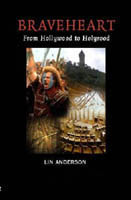 A book came out recently that was launched at the Parliament called Braveheart: From Hollywood to Holyrood. It’s a factual book; John, my husband, and I have run the MacBraveheart website for ten years, and we’ve collected in those ten years hundreds and thousands of stories from round the world on the international impact of the story of Wallace. Not only round the world – in Scotland and the UK as well. So many people have come to us to ask for information. For people who do film courses in Edinburgh we’re the first port of call. We collected everything; newspaper articles, radio, television, we’ve got an archive; plus all these emails from the most amazing places about the impact of Wallace on these people. We wanted to put it together in a format that was accessible. I also do screenwriting, so I wanted to analyse the script in terms of its political impact in Scotland and around the world in many countries that have problems with liberation, liberty and that.
A book came out recently that was launched at the Parliament called Braveheart: From Hollywood to Holyrood. It’s a factual book; John, my husband, and I have run the MacBraveheart website for ten years, and we’ve collected in those ten years hundreds and thousands of stories from round the world on the international impact of the story of Wallace. Not only round the world – in Scotland and the UK as well. So many people have come to us to ask for information. For people who do film courses in Edinburgh we’re the first port of call. We collected everything; newspaper articles, radio, television, we’ve got an archive; plus all these emails from the most amazing places about the impact of Wallace on these people. We wanted to put it together in a format that was accessible. I also do screenwriting, so I wanted to analyse the script in terms of its political impact in Scotland and around the world in many countries that have problems with liberation, liberty and that.
It’s also what I think is the people’s story of the film. There’s a whole chapter analysing the criticisms of it as well, but if you’re remotely interested in its impact or you just like the film and want to know more, I feel I’ve put the voices of all these people out there.
When they reopened the Parliament at the General Assembly, we were phoned by the BBC, and they asked for a cover of the Braveheart music to use in the opening. We told them the various covers, and they chose one. Then when they opened the new Parliament, the man who brought in the mace was an Englishman living in Edinburgh, and they wanted him to wear a kilt. He was a Black Watchman, and he couldn’t wear one because it was a bit political, you know the whole argument about the regiments. So he asked what he should wear and his friend said ‘I’ve got a nice tartan, you could have it.’ And he asked ‘Well what is it?’ And his friend said ‘It’s the Braveheart warrior tartan.’ And he said ‘That’ll do!’ So he was wearing the Braveheart warrior tartan, having been told not to wear the Black Watch tartan because it was political!
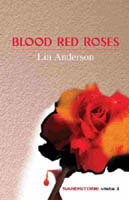 The Cutting Room (ISBN 1841954047 PBK £6.99) and Tamburlaine Must Die (ISBN 1841955329 PBK £9.99), both by Louise Welsh, are published by Canongate. Lin Anderson’s Driftnet (ISBN 1842820346 PBK £9.99), Torch (ISBN 1842820427 PBK £9.99), Deadly Code (ISBN 1905222033 PBK £9.99) and Braveheart: From Hollywood to Holyrood (ISBN 1842820664 PBK £7.99) are all published by Luath Press; Blood Red Roses (ISBN 0954633350 PBK £5.95), the prequel to Driftnet, is published by Sandstone Press. George Orwell’s Shooting an Elephant: And Other Essays is available in Penguin Modern Classics (ISBN 0141187395 PBK £8.99). American Psycho by Bret Easton Ellis is published by Picador (ISBN 0330319922 PBK £7.99)
The Cutting Room (ISBN 1841954047 PBK £6.99) and Tamburlaine Must Die (ISBN 1841955329 PBK £9.99), both by Louise Welsh, are published by Canongate. Lin Anderson’s Driftnet (ISBN 1842820346 PBK £9.99), Torch (ISBN 1842820427 PBK £9.99), Deadly Code (ISBN 1905222033 PBK £9.99) and Braveheart: From Hollywood to Holyrood (ISBN 1842820664 PBK £7.99) are all published by Luath Press; Blood Red Roses (ISBN 0954633350 PBK £5.95), the prequel to Driftnet, is published by Sandstone Press. George Orwell’s Shooting an Elephant: And Other Essays is available in Penguin Modern Classics (ISBN 0141187395 PBK £8.99). American Psycho by Bret Easton Ellis is published by Picador (ISBN 0330319922 PBK £7.99)
Visit Lin and John Anderson’s MacBraveheart website at www.macbraveheart.com

Comments